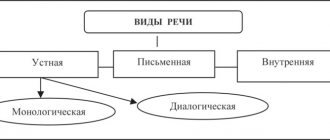Parents who have learned from specialists that their child has problems with speech development often wonder what causes them. This question becomes especially important for them if none of the immediate family had speech disorders. Speech disorders can arise under the influence of unfavorable circumstances, or, as experts say, harmful factors acting from within or without and often combined with each other.
Special and reference literature describes the causes predisposing to the occurrence of speech disorders. They are usually divided into two groups - organic (leading to disruption of mechanisms in the central or peripheral speech apparatus) and functional (disrupting the normal functioning of the speech apparatus).
Speech disorders in children
All forms of speech-language pathology were initially described by physicians because initial descriptions involve clinical intervention. However, these are isolated studies (S.S. Mnukhin, E.I. Kirichenko, A.N. Kornev). Children with various complaints about speech disorders often first go to the doctor, who then refers them to a speech therapist. Accordingly, all research on speech disorders is in the field of speech therapy.
Unlike adults, children independently and spontaneously master language while being in a full-fledged language environment. This is hard and serious work that requires the use of a wide range of cognitive abilities:
- language and intellectual capabilities;
- planning skills;
- ability to concentrate and switch attention;
- states of articulatory praxis, etc.
All this is necessary to master the language. If cognitive abilities are limited and immature, then it will be difficult for a child to learn to speak independently without the help of a specialist.
Epidemiology
The sooner a problem is identified, the easier it is to cope with it - correctional work and medical and psychological assistance will be more effective. Today, in speech therapy, speech disorders are identified at the age of 5-6 years and later.
There are a lot of children with speech disorders in Russia:
| Russia | English-speaking countries | |
| 5-6 years | 25-30% | 4-5% |
| 7-8 years | 17-20% | 3% |
| Over 8 years old | 1% | 1% |
| Boys/girls | 3:1 | 2:1 |
The table shows the percentage of those children who have speech deficiencies that require specialist intervention. By about 6 years of age, children fully master language skills in terms of pronunciation and grammar. Before this, they are allowed to make certain mistakes, according to their age. However, it is important to understand that each age has its own acceptable and unacceptable speech errors.
If we compare with English-speaking countries, the difference is quite noticeable. This large gap is related to diagnostic criteria, not to the children's abilities. Nevertheless, the number of children with speech disorders is quite large. Most often boys suffer from the pathology.
Causes of dysontogenesis
The nature of the development of speech pathologies is traditional. Reasons include:
- Constitutional (hereditary) forms. It occurs most often; most speech disorders have a hereditary factor.
- Somatogenic forms. A child aged 1-2 years suffered some serious illness for his age. If the disease occurs during a sensitive period for speech, this may affect the full development of speech.
- Cerebral-organic forms. They develop as a result of pathologies during pregnancy or difficult childbirth.
- Deprivation forms. Emotional and communicative deprivation, which in most cases occurs among residents of orphanages and orphanages.
- Forms of mixed genesis. Combine two or more of the above forms.
Speech impairment in a child. Causes of speech impairment in a child
The main causes of speech development disorders
The speech function, as well as other higher mental functions (memory, thinking, perception, attention, etc.), is formed in a child gradually, starting from the prenatal period, and this process does not always proceed smoothly.
Deviations in speech development are possible for various reasons. These can be various pathologies during the period of intrauterine development (the most severe speech defects occur when exposed to unfavorable factors for a period of 4 weeks to 4 months of pregnancy), toxicosis, incompatibility of the blood of mother and child according to the Rh factor, viral and endocrine diseases, injuries, hereditary factors, etc.
The cause for concern may be birth trauma and asphyxia during childbirth, pathological course of childbirth, various diseases in the first years of a child’s life (skull injuries accompanied by concussion, etc.). Not least important are unfavorable social and living conditions, leading to children’s pedagogical neglect, disturbances in their emotional-volitional sphere and a deficit in verbal communication.
Parents need to pay attention to the child’s development of the need to speak. Often, when communicating with a small child, adults try to understand and fulfill his requests, without waiting for him to try to express them.
Depending on the duration of exposure to unfavorable factors and which part of the brain is damaged, speech defects of various types occur. Problems with speech can be just one of the manifestations of a general disorder of the nervous system and be accompanied by intellectual and motor impairment.
Currently, speech disorders have been studied very well and many of them are successfully corrected. The main thing is to contact a specialist in time in order to diagnose them in a timely manner and understand: speech impairment is the only problem or is it a consequence of other serious diseases (autism, hearing impairment, central nervous system function, deviations in intellectual development, etc.).
For parents concerned about a child’s speech delay or impairment, it is very difficult to understand how serious their child’s problem is and what needs to be done. As a rule, they hope that everything will go away on its own and waste precious time.
Main types of speech disorders
Speech disorders can be divided into four main types:
• violation of sound pronunciation;
• violation of the rhythm and tempo of speech;
• speech disorders associated with hearing impairment;
• underdevelopment of speech or loss of previously existing speech.
Violation of sound pronunciation
The most common disorder of sound pronunciation is dyslalia, in which there is either the absence of some sounds (the child misses them in words), or their distortion (the child pronounces them incorrectly), or the replacement of one sound with another.
Dyslalia can be functional or mechanical.
With functional dyslalia, there are no disturbances in the structure of the speech apparatus (jaws, teeth, palate, tongue). It is observed during the period when the process of assimilation of sounds occurs. Functional dyslalia can occur due to the general physical weakness of the child due to various somatic diseases (especially during the period of active speech formation), mental retardation (minimal brain dysfunction), delayed speech development, impaired phonemic perception, limited communication, and imitation of incorrect speech. In this case, it is necessary to develop the ability to listen to sounds and actively communicate with the child. Gymnastics can be effective to strengthen the muscles of the tongue.
With mechanical dyslalia, a violation of sound pronunciation is caused by anatomical defects of the organs of articulation, such as irregular teeth structure, absence of incisors or their anomalies, bite defects, pathological changes in the tongue (too large or too small tongue), shortened frenulum.
Sound pronunciation disorders caused by labial anomalies are less common, since congenital defects (deformations) are corrected surgically at an early age. If there are anatomical defects, consultation (and in some cases treatment) of a surgeon and orthodontist is necessary.
Dyslalia can also develop when communicating with children who have not formed the correct sound pronunciation. Being in a bilingual environment has an influence, as well as the attitude of adults towards incorrect pronunciation (many of them do not correct the child’s speech, believing that after some time he himself will learn to speak correctly).
Defects in sound pronunciation in children can be caused by underdevelopment of phonemic hearing (it is difficult for a child to distinguish sounds that are similar in acoustic characteristics: sh-zh, s-z, etc.), decreased physical hearing, and insufficient mental development.
But it is necessary to distinguish complex dyslalia from other similar disorders, in which lateral pronunciation of many phonemes may be observed, the appearance of excess saliva at the time of speech is noted, it is difficult for the child to hold the tongue in the desired position for a long time, the mobility of the tongue, the strength and accuracy of movements are changed.
A more serious disorder of sound pronunciation, resulting from organic damage to the central nervous system, is dysarthria. With dysarthria, not only the pronunciation of individual sounds suffers. Such children have limited mobility of speech and facial muscles. The speech exhibits fuzzy, blurred sound pronunciation, the voice is quiet, weak, and sometimes, on the contrary, harsh; the breathing rhythm is disturbed, speech loses its smoothness, the pace of speech can be accelerated or slowed down.
The causes of dysarthria are various unfavorable factors that can affect in utero during pregnancy (viral infections, toxicosis, pathology of the placenta), at the time of birth (prolonged or rapid labor causing hemorrhage in the baby’s brain) and at an early age (infectious diseases of the brain and brain). membranes: meningitis, meningoencephalitis, etc.).
This disorder can be observed in a severe form (as part of cerebral palsy), or in a mild, so-called erased form of dysarthria (dysarthric component). Children with this diagnosis receive comprehensive speech therapy and medical care in special institutions. In a milder form, disturbances in the movements of the organs of the articulatory apparatus, general and fine motor skills, as well as sound pronunciation can be traced - speech is understandable to others, but unclear.
Children with erased forms of dysarthria do not always immediately attract attention, but they can be distinguished by certain features. They slur their words, eat poorly, refuse to chew solid food because it is difficult for them to do so (such children must be gradually taught to chew solid food - this will contribute to the development of the muscles of the tongue and cheeks). Many skills that require precise movements of different muscle groups are difficult and need to be developed. A child’s education is carried out in different areas: the development of motor skills (general, fine, articulation), correction of sound pronunciation, formation of the rhythmic and melodic side of speech and improvement of diction.
Your baby needs to learn how to rinse his mouth. To do this, you must first learn to puff out your cheeks and hold the air, and then move it from one cheek to the other; suck in your cheeks, while your mouth is open and your lips are closed.
It is necessary to develop fine motor skills of the hands using special exercises. It is necessary to teach the child to fasten buttons (first large, then small) on the doll’s clothes or on a removed dress or coat. At the same time, the adult not only shows the movements, but also helps to make them with the hands of the child himself. To train the ability to lace shoes, various lacing aids are used.
Children with this disorder experience difficulties in visual activities. Therefore, it is necessary to teach them to hold a pencil correctly, regulate the pressure when drawing, and use scissors.
Difficulties are also noted when performing physical exercises and dancing. Children are taught to maintain balance, stand and jump on one leg, correlate their movements with the beginning and end of a musical phrase, and change the nature of movements according to the beat. Parents need to know that if correctional work is not started on time, this can later lead to reading (dyslexia) and writing (dysgraphia) disorders. To achieve results as quickly as possible, the work should be carried out together with a speech therapist; consultations with a psychoneurologist and a specialist in physical therapy are also necessary.
I would like to dwell on one more speech sound pronunciation disorder - rhinolalia, the main difference of which is the presence of a nasal tone in the voice. A nasal tone of speech (nasality) occurs when the stream of exhaled air passes almost entirely through the nose. In this case, sound production is disrupted, which depends both on the activity of the muscles of the soft palate, pharynx and tongue, and on the deformation of the hard palate (cleft), alveolar process, incorrect placement of teeth (in the presence of a cleft lip), and on the violation of the shape of the wing of the nose (nostrils).
The occurrence of clefts is influenced by genetic factors - unfavorable heredity (the presence of clefts in direct or indirect relatives); biological - maternal diseases during pregnancy (influenza, ARVI, mumps, toxoplasmosis); chemical - contact with harmful substances (pesticides, acids); poor environmental conditions; influence of alcohol, nicotine, drugs; uncontrolled use of medications, in particular oversaturation of the fetal body with vitamin A and drugs of the cortisone group.
Usually, this disorder is corrected at an early age through surgery. Basically, speech therapy classes begin immediately after plastic surgery of the palate.
Violation of the rhythm and tempo of speech
Let us dwell on one of the most common types of disturbances in the rhythm and tempo of speech - stuttering. This disorder is characterized by convulsive spasms of the speech muscles. It manifests itself in two forms - the so-called developmental stuttering and reactive stuttering.
Developmental stuttering is usually noted in early childhood, when the child does not speak well enough and has poorly formed articulation of the tongue, lips and cheeks. And if during this period the baby is taught to pronounce difficult words (frying pan, snowman, policeman, etc.), he may begin to stutter.
The basis for the occurrence of such stuttering is overexcitation of the speech areas of the brain. Therefore, the first measure aimed at restoring normal speech should be a “silence regime” for 7-10 days. We must try to exclude all types of emotional influence, completely limit the child’s speech, communicate in a whisper and reduce conversations with the baby to a minimum. Sometimes this helps, but in some cases the disorder is quite persistent.
As soon as a child develops a stutter or something similar to it (it is difficult for the child to start speaking, he finds it difficult to pronounce complex words, repeats the same syllable, etc.), you need to contact a speech therapist and strictly follow all his instructions.
Reactive stuttering (develops as a reaction to some strong influence) is most often the result of fear, mental trauma (severe conflicts in the family) or debilitating long-term illnesses.
Children with a weakened nervous system who have a predisposition to this speech disorder (stuttering in close relatives) begin to stutter. Such children often show signs of a neurotic state: poor appetite, restless sleep, night terrors, urinary incontinence, etc.
A child who stutters must be under the supervision of a neurologist. He needs both medical and speech therapy help. The main thing is not to fix the baby’s attention on this defect, not to imitate him and not to repeat incorrectly pronounced words after him. Your task is to teach him to speak more slowly. Most likely, the child is in a hurry not only to speak, so it is necessary to normalize the baby’s entire motor mode using calm games. The atmosphere in the family should also be smooth and calm.
Parents need to remember that if a child is easily excitable, whiny, sleeps restlessly, etc., they should not read to him too much, tell him long tales, or rush to teach him difficult words and complex phrases. This especially applies to children who have speech impairments that are acceptable for a given age. Against the background of untrained articulation, an abundance of new words will easily lead to a “disruption” of nervous activity. In other words, the level of speech development should correspond to the level of development of the baby as a whole. When this does not happen, there is a risk of stuttering.
It should be kept in mind that stuttering may recur after treatment. There are age periods in which the onset of the disease or its recurrence is most likely (from 2 to 6 years). The reasons for relapse are the same as the reasons that originally caused stuttering: conflicts in the family, overwork, infections that weaken the body. Consequently, the recurrence of stuttering can be prevented if people around them try to create a calm environment for the child.
Speech disorders associated with hearing loss
Already in the first year of life, you can draw your own conclusions about the level of speech development of the child. You should pay attention to the noise. If at 3-4 months it does not become more complicated and does not turn into babbling, but gradually fades away, this may indicate serious hearing impairment. As soon as possible, you need to examine the child’s hearing, contact an otolaryngologist, and have an audiogram done.
How to test your child's hearing at home?
The simplest method of testing hearing is to study it using whispered and ordinary conversational speech. Being at a distance of 5-6 meters from the baby (his back is to you), whisper words that are well known to him. Children with full hearing usually hear whispers. If the child cannot hear at such a distance, you need to gradually approach him until he can repeat all the words you said.
During the examination, it is necessary to take into account the general condition of the baby: fatigue, attention, readiness to complete the task. A tired child is easily distracted, does not perceive the meaning of the task assigned to him, and may give inaccurate answers. In the case when the baby does not yet speak oral language and does not understand verbal instructions, you can use sounding (tambourine, whistle) and voiced (bird, barking dog, etc.) toys.
If the child does not hear the whisper, move away from him at the same distance and say other words familiar to him in a voice at normal conversational volume. This method makes it possible to determine at what distance the baby hears normal speech. If you suspect that he has difficulty hearing, you should consult an otolaryngologist. If a young child hears speech at normal conversational volume at a distance of 3-4 meters (that is, physical hearing is normal), his speech development can be helped at home (19).
In case of hearing impairment, early corrective work has the greatest positive effect. If a hearing aid is indicated for your child, it must be used - with the help of the device, speech will be able to develop quite successfully. You need to talk to your baby slowly, so that he has the opportunity to see your face, facial expressions, articulation while you pronounce words - this will develop the ability to read lips.
Speech underdevelopment or loss of previously existing speech
There is a violation of speech activity - alalia, which can occur as a result of late maturation of nerve cells in the speech zone of the left hemisphere or as a result of early damage to these cells due to infections, intoxications, birth injuries, shortly after birth. There is motor alalia, when the child’s speech is poorly developed, and sensory alalia, when understanding the speech of other people is impaired. The most common form of alalia is a mixed form with a predominance of motor or sensory disorders. The speech of children suffering from alalia develops late, their vocabulary is replenished slowly, they do not change words according to numbers, cases, there are no connections of words in the sentence, so at 7-8 years old the child speaks like a 2-3-year-old child (“Katya is walking in kindergarten” ). It is difficult for them to pronounce sounds in a sequence, so they read poorly and do not understand what they read well. In such children, both general motor skills are insufficiently developed (they are inactive, awkward, slow) and finger movements.
With this diagnosis, logorhythmic exercises and exercises for the development of finely coordinated hand movements are very effective (we give examples of such tasks below). Not only a speech therapist, but also a psychologist, defectologist, psychoneurologist and other specialists (physical therapy, massage) should take part in working with such children.
If speech was already formed, but was lost due to focal damage to the speech areas of the brain, then we can talk about another speech disorder - aphasia. Even a very severe form of this disorder goes away relatively quickly in children if the main cause of the speech disorder is eliminated - a brain tumor is removed, hemorrhage after an injury has resolved, etc.
An important part of correctional work with non-speaking children are games and exercises aimed at improving the movements of the organs of the articulatory apparatus, relieving their muscle tension, and developing the ability to feel and control their movements.
In relation to young children (up to 5 years old), who master speech skills at a later date, specialists often use the diagnosis of SRD (speech development delay). This diagnosis can be made either independently or as a sign of some serious disorder. To understand this, you need to have an idea of the age-related characteristics of speech development, which will be discussed further.
When to seek professional help
By the end of the first year of life, with intact hearing, the child begins to develop understanding of speech. If this does not happen, that is, the baby does not engage in the work of imitating the actions and speech of adults, and is not active in activities with toys, then one can suspect underdevelopment of the intellect.
In this case, the semantic side of speech will suffer more, so the main help should be aimed at developing cognitive interests.
If a child at 2 years old has normal hearing, but speech is not developed, he needs active communication with adults through gestures and any sounds, and then in the near future the baby will have to develop words.
The child is 2 years 7 months old and he still doesn’t speak? It is necessary to start special classes to create the need for conversation. At this age, if the baby has problems with speech, he needs to be shown to specialists and examined.
Adults should never reproach a child for experiencing certain difficulties in the process of verbal communication, as this can cause fear of having to speak and fear of making a mistake. The child must be encouraged and supported in the slightest attempts to use words. You should specifically create situations in which the baby will be forced to say something.
If, with intact hearing and normal intelligence, by the age of three the child does not have phrasal speech or uses incorrect sentences, we can talk about systemic speech disorders (in understanding the meaning of words, changing them, using them).
The speech of such children develops better in the process of some kind of activity, so it is necessary to play together, involve the child in housework, read books that are simple in content, and give comments to everything that the child sees and does. When communicating with your baby, you should use simple, laconic sentences, and words for repetition should be used in different case forms.
If a four-year-old child’s sound pronunciation is significantly behind the norm, that is, there are numerous substitutions in speech: instead of hissing ones, whistling ones are pronounced (sh-s, zh-z, sch-s), the sound p is replaced by l, l or y, replacement of hard consonants with corresponding soft - this indicates a violation of phonemic hearing and, accordingly, the need to conduct classes for the purpose of its development.
There may also be a distorted pronunciation of individual consonant sounds: p throat; p single-impact (that is, pronounced without vibration of the tip of the tongue); l bilabial, similar to English w; whistling sounds s, z, z, pronounced by inserting the tip of the tongue between the teeth.
These speech defects are not age-related and will not disappear on their own, so parents do not need to postpone their correction to a later date, so as not to reinforce incorrect pronunciation in speech. To set the sound, you should contact a specialist, and the parents themselves can help the child develop the ability to use the set sound. At first, the baby can pronounce the sound as it should in some words, but still replace it in others. The role of adults is to correct the child and ask him to repeat the word correctly. When reinforcing sounds, the words that the child pronounces correctly are used.
By the age of five, undeveloped coherent speech, low speech activity, lack of curiosity, and poor vocabulary may indicate mental retardation.
A child with mental retardation needs to activate his cognitive interests, for which he needs to read more books about nature, about animals, and encourage him to retell texts.
To summarize the above, I would like to note that it is necessary to pay attention to problems that may appear already in the early stages of a child’s development. If your baby is in his second year and he doesn’t babble, is inactive, doesn’t communicate well, and is a little emotional, all this should alert parents. Such a child should be shown to a neurologist, otolaryngologist, speech therapist, an EEG - electroencephalography of the brain, and, if necessary, an audiogram to test hearing. It is better to prevent problems that may arise later than to face them.
Partial PNR
PND stands for primary speech underdevelopment. Classification of partial PNR:
- Functional dyslalia. These are defects in individual sounds that can be easily eliminated (in a couple of weeks/months).
- Articulatory dyspraxia (dysphonetic, dysphonological and dynamic forms). It represents polymorphic pronunciation disorders that are associated with a violation of cerebral support, i.e. with inferiority at the neurobiological level. Dyspraxia may be accompanied by problems with vocabulary and grammar. Requires longer correction.
- Developmental dysarthria. The causes of dysarthria are pathologies during pregnancy and birth trauma.
- Rhinolalia. These are serious speech disorders that occur due to the incorrect structure of the dentofacial apparatus.
- Dysgrammatism. It manifests itself in selective violation of the rules of grammar, agreement of words by gender, number, cases, etc. Reflects exclusively the grammatical side.
This classification is notable for its clinical focus. That is, it can be used by both speech therapists and doctors.
In addition to partial speech disorders, secondary speech underdevelopment is also distinguished. They are associated with pathologies of physical and mental development (for example, hearing impairment, mental retardation, mental retardation, etc.).
Reviews and comments
Now you can practice and find speech errors in this article or share other examples you know. Also, take a look at our literacy course.
We also recommend reading:
- Storytelling
- Our. Native. Russian.
- Orthoepy - why it is important to speak correctly and how these rules arise
- Six ways to learn from your mistakes
- Recommendations for learning Russian
- Learning a foreign language: old rules about the main thing
- How to learn to speak beautifully
- How to independently learn to write correctly in Russian
- Lukomorye, cat and literacy
- Development of speech culture
- Learning your native language: a selection of useful materials
Keywords:_D1048, _D1049, 1Russian, 1Storytelling
Total PNR
With total speech impairment (TSI), there are deficiencies in all areas of the language: phonology, sound pronunciation, grammar and vocabulary. The child's mastery of all language means is generally impaired.
The disorders presented in the classification are classified as severe:
1. Alalic variant (motor and sensory alalia). With motor alalia, a child under 4-7 years of age does not use speech, except for a set of babbling words (for example, woof-woof, co-co, bi-bi). The child cannot fully communicate, which entails serious impairments in communication capabilities. It is relatively rare - 0.5%.
Sensory alalia is an even more severe condition in which the child does not understand spoken speech and does not connect words with meaning. The disease has been little studied and is difficult to diagnose. Correction not started in time (from 2-3 years of age) can cause serious maladaptation and lead to disability.
2. Paraalalic version of THP. The symptoms and signs are similar to motor alalia, but it proceeds much easier and is overcome more quickly (in 2-3 years).
3. Clinical forms with a complex type of disorder (“mixed”).
If by the end of preschool age it is not possible to cope with dysontogenesis, the child is sent to study at a speech school. To achieve noticeable results, correction work must continue for at least 5-6 years. A regular school can only aggravate the child’s condition: serious difficulties will arise in learning, and a lack of oral speech causes deficiencies in written language.
Comorbidity
Total PND is characterized by a high comorbidity rate. 60-70% of children with sound pronunciation disorders have problems with attention, memory and the emotional sphere. 50% of children with dyslexia and 60-80% of children with mental retardation or mental retardation have oral speech disorders.
Speech impairment is quite often accompanied by many disorders:
1. Cognitive deficit:
- random access memory;
- verbal-logical functions (the ability to think categorically using generalizing concepts);
- successive operations;
- finger and articulatory praxis;
- attention (auditory, rarely visual);
- immaturity of gaming competence.
2. Personal sphere:
- surface of social connections;
- immaturity of the emotional-volitional sphere.
3. Communicative competence:
- poor command of dialogue (especially monologue);
- difficulties in establishing partnerships.
The lack of language means limits the possibility of mastering verbal and logical skills in thinking. This can affect the personal sphere, because difficulties arise in communicating with peers and adults. If the child received timely and comprehensive help, the outcome will be more favorable. Comprehensive care means both the participation of a speech therapist and the participation of doctors.
Dysontogenesis is dangerous with negative consequences. The child has difficulties in learning in basic subjects, there is an inferiority of socio-cultural discourse and behavioral disturbances. It is worth talking separately about dyslexia and dysgraphia, since these are the most serious disorders that follow speech impairment.
Ways to correct and prevent speech errors
How to prevent speech errors? Work on your speech should include:
- Reading fiction.
- Visiting theaters, museums, exhibitions.
- Communication with educated people.
- Constant work to improve speech culture.
Online course “Russian language”
Speech errors are one of the most problematic topics that receive little attention in school. There are not so many topics in the Russian language in which people most often make mistakes - about 20. We decided to devote the course “Russian Language” to these topics. During the classes, you will have the opportunity to practice competent writing skills using a special system of multiple distributed repetitions of material through simple exercises and special memorization techniques.
Dyslexia through the eyes of a doctor
Dyslexia as an independent disorder was first described at the end of the 19th century by English ophthalmologists. The pathology was defined as word blindness - the child is intellectually developed, but cannot recognize words. In Russia, such cases were first described by R.A. Tkachev and S.S. Mnukhin.
Dyslexia is a specific reading disorder. About 10% of children experience difficulties mastering reading during their school years. Compared to other children, they are not able to learn to read in the proper time. After finishing school, many of them remain semi-literate.
Dyslexia is a condition whose main manifestation is a persistent, selective inability to master the skill of reading, despite a sufficient level of intellectual and speech/language development, the absence of hearing and visual impairments, and optimal learning conditions.
Diagnostic criteria according to ICD-10 – F81.0. Specific reading disorder.
Signs of dyslexia:
- Reading technique and/or reading comprehension is below what is expected for given intellectual development. First, there is a slow development of syllabic reading, and then slow reading in words, which greatly complicates the understanding of texts. Both in the lower grades and in the older grades, the child automatically reads most of the words syllable by syllable.
- The disorder is not a direct consequence of a visual or hearing defect, or a neurotic disorder.
Symptoms of dyslexia vary by language. In the English language, dyslexia can be recognized by incorrect reading and a huge number of errors, in the Russian language - by extreme slowness and automation.
Epidemiology of dyslexia
This pathology has been poorly studied in Russia, while in English-speaking countries millions of books and articles have been written on the topic of dyslexia, and in the USA the problem was discussed at the Congress level. The results of a survey conducted by the Association of Parents of Dyslexics showed that the vast majority of parents and more than half of teachers in Russia do not have the slightest idea about dyslexia. In fact, dyslexic children are left to their own devices and do not receive the necessary help. There are a lot of such children:
- in the Russian population of school-age children 5-6%;
- L/m ratio: severe forms – 1:4.5, medium form. heavy – 1:1.5;
- among children with mental retardation – 50%
- among children with speech underdevelopment – 40-50%.
5-6% on a Russian scale is approximately 700-800 thousand children. After finishing school, they feel like foreigners in their native country, since they cannot work with texts. These are huge numbers and from this side dyslexia becomes a socially significant problem.
Dyslexia is characterized by sexual dimorphism in favor of boys. Dyslexic boys are many times more common than girls.
Cerebral mechanisms of dyslexia
Reading is a rather labor-intensive process that develops certain brain structures. Dyslexics have difficulty reading because their brains have serious developmental features - malformations or ectopia, when neurons are located in the wrong place where they are supposed to be. This study was conducted by Galaburda in 1985. Look at fig. 1 - everything that is indicated in red are numerous zones of ectopia.
Rice. 1.
The dyslexic brain shows signs of dysembryogenesis. MRI can identify typical, recurring abnormalities in certain areas of the brain. In Fig. 2 yellow-red color shows a decrease in gray matter density in dyslexics, and blue color shows an increase. These are also signs of dysontogenesis, which are most often found in the left temporal lobe of the posterior part of the middle temporal gyrus.
Rice. 2.
Functional MRI can identify key areas of the brain involved in text processing. Look at fig. 3 – while reading, a normally reading child activates 3 key zones, highlighted in red: superior temporal, frontal and inferior temporo-occipital. In dyslexics, only one zone is allocated, and the temporal and temporo-occipital areas are not involved in information processing - this is a sure sign that the brain is not working imperfectly. Dyslexia can be improved with special exercises and rehabilitation.
Rice. 3.
In Fig. Figure 4 shows a graph of reading pace changes. In the 6th grade, children reach a plateau, that is, reading in pace and speed does not change and remains unproductive until graduation.
Rice. 4.
Psychopathological symptoms in dyslexia
This pathology occurs in conjunction with various psychopathological syndromes. Among them:
- cerebrovascular disease;
- attention deficit disorder;
- mental infantilism syndromes;
- ADHD;
- intellectual-mnestic deficiency;
- neurosis-like and neurotic syndromes;
- reading phobia;
- school phobia;
- delinquency.
All these problems arise due to psychological maladjustment. Persistent problems can deform the personality in the process of its formation and lead to sad results. Dyslexia interferes with the learning process, and children experience such difficulties painfully. Features of the social situation of a dyslexic child:
- chronic failure;
- chronic frustration (reading phobia, school phobia);
- disharmony of parent-child relationships (secondary);
- low social status among peers;
- restrictions in choosing a profession;
- inaccessibility of higher education.
Unfortunately, the school often does not notice that the child has problems and does not meet them halfway. Even parents do not realize the full danger of the situation and add problems to the child by getting annoyed and scolding him for poor performance. As a result, the child’s maladaptation only intensifies.
According to statistics, the social status of adults with dyslexia is much lower than that of other people. This is quite natural, because mastering a profession and competition in the labor market for dyslexics is a tough environment where they lose. Features of the social situation of an adult dyslexic:
- cultural development of the individual - as in the pre-literate era;
- cultural deprivation due to deprivation of cultural discourse through texts;
- social discrimination, which is caused by illiteracy.
Types of speech errors
First, let's figure out what speech errors are. Speech errors are any cases of deviation from current language norms. Without their knowledge, a person can live, work and communicate normally with others. But the effectiveness of the actions taken in certain cases may suffer. In this regard, there is a risk of being misunderstood or misunderstood. And in situations where our personal success depends on it, this is unacceptable.
The author of the classification of speech errors given below is Doctor of Philology Yu. V. Fomenko. Its division, in our opinion, is the simplest, devoid of academic pretentiousness and, as a result, understandable even to those who do not have a special education.
Types of speech errors:
Rehabilitation of children with dyslexia
It is important to begin providing assistance in a timely manner, in grades 1-2, to compensate for dyslexia and prevent social maladjustment. Help should be comprehensive:
- psychological and pedagogical correction of reading disorders;
- drug treatment: nootropics (Nootropil, Phenotropil, Pantogam, Cortexin, Semax, etc.);
- psychotherapeutic assistance in the family.
To master reading skills, a child needs to study with specialists and do additional homework. All this can be combined on the online platform SLOGY.RU, where studies take place in a distance learning format.








